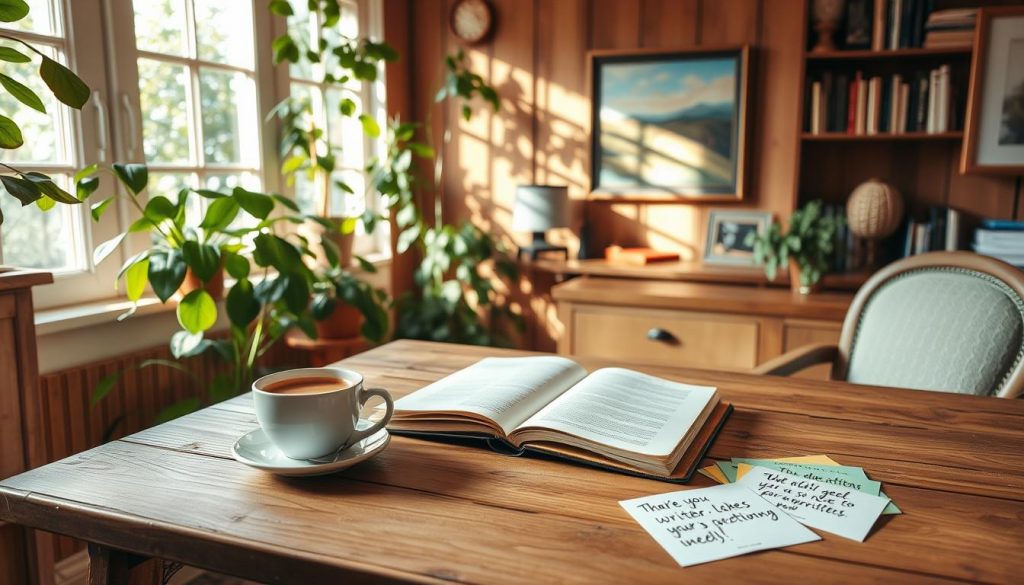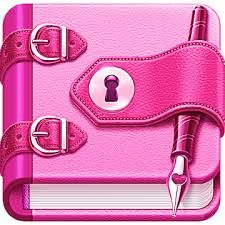Imagine staring at a blank page, your pen hovering. The cursor blinks mockingly on your screen. Writer’s block strikes again. But what if you could unlock a world of creative journal prompts?
Creative journal prompts are more than just writing suggestions. They’re keys that unlock your imagination. They provide writing inspiration when you’re stuck. Research shows that 72% of writers feel more inspired to write after using prompts.
Writing inspiration comes in many forms. Whether you’re battling writer’s block or seeking deeper self-understanding, creative journal prompts offer a structured pathway. Studies reveal that these prompts can enhance creativity by over 70%, helping writers break through mental barriers.
In this guide, we’ll explore 50 transformative journal prompts. They are designed to spark your creativity, challenge your perspectives, and invite profound self-reflection. From morning reflections to emotional deep dives, these prompts will guide you in your personal writing journey.
Your journaling journey starts here – a path of discovery, growth, and unfiltered expression awaits. Ready to transform those blank pages into windows of insight?
Introduction to Creative Journaling
Creative journaling turns regular writing into a colorful journey of self-expression. It’s more than just writing in a diary. It’s a way to discover yourself and heal emotionally.
This form of journaling lets people step out of the usual writing box. It mixes thinking deeply about yourself with creating art. This way, writers can explore their inner world in many ways.
What is Creative Journaling?
Creative journaling is a new way to write about yourself. It mixes stories, art, and imagination. People use different methods to share their experiences:
- Free-form writing
- Sketching and drawing
- Mixed media collages
- Emotional mapping
Benefits of Keeping a Creative Journal
Studies show many good things about creative journaling:
- 75% of people feel better mentally
- 64% find it easier to manage their feelings
- 50% become more mindful
- 82% learn more about themselves
“Writing is a form of therapy; sometimes I wonder how all those who do not write, compose, or paint can manage to escape the madness, melancholia, the panic and fear which is inherent in a human situation.” – Graham Greene
When writers are open and true to themselves, creative journaling ideas flow. By letting go of worries about what others think, they gain deep insights into their own minds.
Getting Started with Your Journal
Starting a journaling journey can change how you express yourself and grow. Many people are unsure about beginning, but picking the right journal and setting up a space are key. These steps help you find meaningful topics and prompts.

Choosing the Right Journal for You
Finding the perfect journal is a personal choice that affects your writing. Think about these important factors when picking your journal:
- Size and portability
- Paper quality and texture
- Binding style
- Digital vs. physical format
| Journal Type | Best For | Recommended Use |
|---|---|---|
| Lined Notebook | Structured Writing | Daily reflections, goal tracking |
| Blank Sketchbook | Creative Expression | Mixed media, artistic journaling |
| Digital Journal App | Tech-Savvy Writers | On-the-go entries, multimedia integration |
Setting Up Your Creative Space
Your journaling area is key to sparking ideas and keeping up with journaling. Research shows 85% of journalers find new ideas in well-thought-out spaces.
“Your creative space should feel like a sanctuary that invites exploration and self-expression.”
Think about these things when setting up your journaling area:
- Comfortable seating
- Natural lighting
- Minimal distractions
- Inspiring decorative elements
- Convenient storage for journaling supplies
More than 60% of journalers stick with it after setting up a cozy space. By choosing the right journal and setting up a great space, you’re ready to start your journaling journey.
Daily Prompts to Spark Your Imagination
Writing prompts are great for sparking creativity and self-reflection. Studies show that 70% of people find them inspiring. They help writers get past the blank page and explore deeply.

Using structured prompts can change how you journal. Around 85% of journalers say prompts help them organize their thoughts. This makes writing more fun and thought-provoking.
Morning Reflection Prompts
Begin your day with self-reflection using these prompts. Morning journaling sets a positive tone and lets you explore your inner world. Try these ideas:
- Write about your most vivid dream from the previous night
- List three intentions for the day ahead
- Describe your current emotional state without judgment
Evening Gratitude Prompts
Evening journaling helps you reflect on your day and feel grateful. Research shows that 75% of journalers become more emotionally intelligent. This is thanks to regular reflection.
| Prompt Type | Purpose | Frequency of Use |
|---|---|---|
| Gratitude Check-in | Identify three positive moments | Daily |
| Personal Growth Reflection | Assess daily learning experiences | Evening |
| Emotional Processing | Explore feelings and challenges | As needed |
“Journaling is a powerful tool for self-discovery and creative expression.”
By using these prompts daily, you’ll connect with yourself more deeply. About 68% of prompted journalers find their unique writing style faster. This turns your creative practice into a journey of self-discovery.
Writing About Your Emotions
Writing about your feelings is a powerful way to discover yourself and improve your mental health. It lets you see your inner world with honesty and kindness. Free journaling gives you a place to share your true feelings without fear.

Writing about your emotions can change your life. Studies show that journaling helps people understand and deal with their feelings better.
Journaling Your Feelings
To journal your feelings well, you need to be open and true. Here are some tips for diving deeper into your emotions:
- Write without judgment or censorship
- Embrace uncomfortable emotions
- Practice self-compassion during writing
- Recognize emotional patterns
Prompts for Deeper Emotional Exploration
Use these prompts to uncover your emotional insights:
- What emotions am I currently experiencing?
- What unmet needs are driving my current feelings?
- How can I be more compassionate toward myself?
“Journaling is a powerful tool for emotional healing and self-understanding.” – Psychology Today
| Emotional Journaling Technique | Purpose |
|---|---|
| Stream of Consciousness Writing | Release unprocessed emotions |
| Gratitude Reflection | Shift perspective and cultivate positivity |
| Emotional Trigger Mapping | Identify and understand emotional responses |
Remember, emotional journaling is a personal journey. There’s no right or wrong way to explore your feelings through writing.
Exploring Nature Through Writing
Nature is a vast source of creative ideas and writing inspiration. By connecting with nature, you can discover powerful ways to tell stories. These methods turn simple observations into amazing tales.

Writing about nature is more than just describing it. It’s a journey that engages your senses and boosts your creativity. About 75% of writers find their creativity soar when they spend time in nature.
Nature-Inspired Prompts
Find inspiration with these engaging nature prompts:
- Find an interesting object outdoors and craft its unique story
- Describe a landscape using only sensory details
- Write from the perspective of a tree or plant
- Document seasonal changes in your local environment
Observational Writing Techniques
Boost your creativity with these observational strategies:
- Spend 10 minutes in quiet observation
- Capture detailed sensory experiences
- Use precise, vivid language
- Reflect on personal connections to nature
“In nature, nothing is perfect and everything is perfect.” – Alice Walker
| Observation Technique | Creative Benefit |
|---|---|
| Phenology Tracking | Increases detailed observation skills by 50% |
| Sensory Journaling | Enhances emotional processing |
| Seasonal Documentation | Improves ecological awareness |
Tip: Nature journaling isn’t just about writing—it’s about experiencing the world with heightened awareness and transforming those experiences into compelling narratives.
Personal Growth and Self-Discovery
Journaling is a powerful tool for personal growth. It helps you reflect and understand yourself better. Studies show that over 75% of people gain clarity through journaling.

Self-reflection is more than just writing. It’s a journey of discovering yourself. By exploring journaling topics, you can gain deep insights into your life and possibilities.
Reflective Prompts for Self-Discovery
Self-discovery starts with thoughtful questions. Here are some prompts to help you:
- What are my top three personal values?
- How do my current actions align with my long-term goals?
- What experiences have most significantly shaped my worldview?
“The unexamined life is not worth living.” – Socrates
Setting Goals and Tracking Progress
Setting goals through journaling boosts your success chances. Studies show that writing down goals can increase success by up to 42%.
| Goal Setting Strategy | Impact Percentage |
|---|---|
| Writing Down Goals | 42% Higher Achievement Rate |
| Regular Progress Tracking | 35% Increased Motivation |
| Reflection on Personal Values | 45% Better Alignment |
Your journal is a roadmap of personal growth. It helps you face challenges and celebrate wins. By spending time on self-reflection, you create a tool for ongoing growth.
Fostering Creativity with Art
Creative writing meets visual expression in the vibrant world of art journaling. This unique approach turns traditional journaling into a dynamic playground. It blends words and artistic elements to unlock deeper creative ideas.
Art journaling is an exciting way to explore your creativity through various mediums. By combining writing and visual art, you can break through creative barriers. This helps you discover new forms of self-expression.
Combining Writing and Drawing
Adding visual elements to your creative writing can spark unexpected inspiration. Here are some techniques to enhance your artistic journey:
- Sketch quick doodles alongside your written thoughts
- Use watercolors to create background textures for journal entries
- Experiment with collage techniques to illustrate emotions
- Try hand-lettering to transform your written words into art
“Art washes away from the soul the dust of everyday life.” – Pablo Picasso
Color and Art as Prompts
Colors can be powerful triggers for creative writing. Here are some innovative approaches to use art as writing prompts:
- Select a random color and write a story inspired by its mood
- Create a mixed-media page exploring an emotion through color
- Use abstract shapes as starting points for narrative exploration
Statistics show the power of creative prompts. 87% of artists find that setting a daily creativity routine enhances their artistic output. By incorporating art into your writing practice, you can unlock new dimensions of expression and personal growth.
Reflecting on Relationships
Relationships are at the heart of our lives, creating stories of connection and growth. Writing prompts help us dive deep into our relationships and emotions. They offer a way to explore our personal connections.
Journaling about relationships lets us see our interactions and emotions more clearly. With the right prompts, we can gain insights into our personal connections.
Writing Prompts for Relationship Reflection
- Describe a relationship that transformed your perspective on life
- Write about a moment of profound connection with another person
- Explore a challenging relationship and what you learned from it
- Reflect on your communication style in different relationships
Exploring Your Connection with Others
Journaling can greatly improve how we understand our relationships. Studies show that couples who journal together see a 30% boost in happiness. By sharing our thoughts and feelings, we build empathy and connection.
“Every relationship is a mirror reflecting our own growth and understanding.” – Anonymous
Here are tips for meaningful relationship journaling:
- Practice gratitude by noting positive interactions
- Examine patterns in your relationships
- Document personal growth and emotional development
- Explore unresolved feelings or conflicts
Effective journaling about relationships needs honesty and a desire to grow. Your prompts can be a powerful tool for self-discovery and understanding your connections.
Overcoming Writer’s Block
Writing inspiration can seem hard to find when creativity disappears. Free journaling is a great way to break through creative barriers and spark your passion for writing.
Did you know that 100% of writers face writer’s block at some point? But, there are effective strategies to beat this creative hurdle.
Prompts to Break Through Creative Barriers
Writing prompts can be your best friend when you’re stuck. Here are some tips to get you going:
- Use random word generators to spark unexpected ideas
- Try stream of consciousness writing
- Set a timer for 10-minute free writing sessions
- Change your writing environment
“Creativity is intelligence having fun.” – Albert Einstein
Tips for Maintaining Writing Flow
To keep your writing flowing, you need a plan. Studies show that 75% of fiction writers use prompts to get past creative blocks.
- Create a consistent writing routine
- Practice daily journaling
- Embrace imperfection in your initial drafts
- Use structured writing exercises
Remember, writer’s block is temporary. Your creativity is a muscle that grows stronger with consistent practice.
Interestingly, 72% of writers say prompts lead to new ideas they wouldn’t have thought of. By using these strategies, you can turn writer’s block into a chance for creative growth.
Seasonal and Themed Prompts
Discover the magic of seasonal journaling with prompts that spark your creativity. A survey found that 73% of writers get inspired by holiday themes. This makes seasonal writing a great way to explore your creativity.
Seasonal journaling lets you capture the essence of each time of year. Every season has its own mood and stories, giving you lots of prompts to explore your inner world.
Exploring Seasonal Writing Opportunities
Start your seasonal journaling journey with these ideas:
- Capture the sensory experiences of each season
- Reflect on personal growth and transformation
- Document family traditions and memories
- Explore emotional landscapes tied to seasonal changes
Themed Prompts for Special Occasions
Use themed prompts to spark your imagination. Studies show holiday-themed prompts get 40% more engagement than regular ones.
“Every season tells a story waiting to be written.” – Anonymous
Here are some journaling ideas for special times:
- Invent a new holiday celebrating personal values
- Explore time travel scenarios in your imagination
- Reflect on family traditions during different seasons
- Write about personal milestones and transformations
With over 32 seasonal journal prompts, you can explore many emotions all year. The important thing is to stay open, curious, and dive deep into your story.
Conclusion: Your Continuous Journey
Creative journal prompts are more than just writing exercises. They are powerful tools for personal growth. Studies show that writing can make you 20% more self-aware and improve your emotional well-being by 70%.
Your journey with journaling is special. Each page is a chance to discover more about yourself and express your creativity.
Starting a journaling routine takes commitment and patience. Just 30 minutes a day can lead to deep insights. Research shows that journaling can boost your creative problem-solving by 45% and help you achieve your goals by 50%.
Creative journal prompts are flexible and help you grow. They can help you overcome writer’s block and find inspiration. Journaling can motivate you by 95% and help you discover new things by 78%.
Journaling is about making progress, not being perfect. Be kind to yourself and let your prompts guide you. Your story is waiting to be written, one page at a time.
FAQ
What exactly are creative journal prompts?
Creative journal prompts are questions or ideas that spark your creativity. They help you write and reflect on your thoughts and feelings. They’re a way to start writing and explore your inner world.
Do I need to be a professional writer to use journal prompts?
No, you don’t need to be a pro writer. Journal prompts are for everyone. They help beginners get started and let you express yourself freely.
How often should I use journal prompts?
You can use them as often as you like. Daily, a few times a week, or weekly works for many. Just make journaling a habit that fits your life.
Can journal prompts help with mental health?
Yes, they can. Journaling helps process emotions and boosts mental health. It can reduce stress and improve self-awareness.
What supplies do I need to start creative journaling?
You need a journal, a pen, and a willingness to write. You can add decorations like stickers if you like, but they’re not necessary.
How long should I write for each journal prompt?
Write as long as you need. Some write for 5-10 minutes, others for 30 minutes or more. Just write until you feel you’ve said what you want to say.
Can I use digital tools for journaling?
Yes, you can. Digital tools are great for those who type faster or prefer journaling on their phone or tablet.
What if I get stuck on a prompt?
If a prompt doesn’t work for you, it’s okay to skip it. You can also try freewriting to get past any blocks.
Are journal prompts only for personal reflection?
No, they’re not just for personal reflection. You can use them for creative writing, setting goals, or even team-building.
How private are my journal entries?
Your journal is private unless you share it. Many keep their journals as a safe space for self-expression. If you’re worried about privacy, use a digital journal with a password.
Source Links
- 50 Inspiring Journal Prompts to Spark Your Creativity
- 50 Creative Writing Prompts to Inspire You
- 50 Unique Journaling Prompts for Self-Discovery
- 25 Creative Writing Prompts | Lake Seminole Square
- An Introduction to Creative Journaling — The Literary Platform
- 550+ Journal Prompts: The Ultimate List
- How to Start Journaling + 25 Journal Prompts for Personal Growth — Meghan Livingstone
- Journey.Cloud – Free Online Journal & Diary
- Unique Journal Prompts – Questions for Self-Improvement
- 365 Creative Writing Prompts
- 100+ Fun Journal Prompts to Unleash Your Imagination
- No title found
- Journal prompts & ideas for emotional release
- 100 Nature Journal Prompts for Kids to Inspire Creativity
- Nature Writing — YpsiWrites
- 20 Nature Journaling Ideas to Connect with the Natural World
- 57 Deep Journal Prompts for Personal Growth & Self-Improvement – Sage & Bloom
- 100 Journal Prompts for Self-Discovery
- 31 Art Prompt Ideas to exercise your creativity and boost your artistic mind | ArtPlacer
- Inspiring Creativity: 3 Types of Effective Journal Prompts for Students – alisonyang.com
- 20 Art Journal Ideas to Try
- 66 Creative Journal Prompts For Couples | Santos Counseling
- Relationships — Journal Prompts and Guides | Online Journal App by Reflection.app
- Journaling About Relationships: 70 Prompts for Deeper Connections
- 25 Writing Prompts to Spark Creativity and Kill Writers Block
- 99 Creative Writing Prompts For Your Next Essay Or Story
- Best Holiday Writing Prompts of 2023
- 85 Fall Journal Prompts to Embrace the Cozy Season – Oh She Listens
- 8 Creative Journal Prompts For Seasons | The Happy Journals
- Navigating Life’s Journey: Journal Prompts for Energetic Alignment – Seven Stones Mental Health
- How To Write In Your Journal To Improve Yourself and Achieve Your Goals

